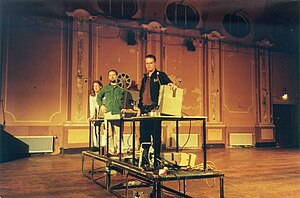The Tape-beatles
| The Tape-beatles | |
|---|---|

The Tape-beatles in Berlin, 1997. From left to right: John Heck, Lloyd Dunn, Ralph Johnson
|
|
| Background information | |
| Origin | Iowa City, Iowa, USA |
| Genres |
Musique concrète Sound collage |
| Years active | 1986–present |
| Labels | Public Works Productions, Staalplaat (Amsterdam, Berlin), DOVentertainment (Toronto, Canada) |
| Website | Official website |
| Members |
Lloyd Dunn John Heck Ralph Johnson Paul Neff Linda Morgan Brown |
The Tape-beatles (also known as Public Works) are a multi-media group that formed in Iowa City in December 1986. Its members have included Lloyd Dunn, John Heck, Ralph Johnson, Paul Neff, and Linda Morgan Brown. Beginning with analog tape recorders, and later expanding to include digital technology and film media, the group has used collage techniques to create works that challenge the notion of intellectual property. Their works make extensive use of materials appropriated from various sources through a process they call "Plagiarism®". The Tape-beatles' body of work consists mainly of music and audio art recordings, expanded and performed cinema performances, videos, printed publications, as well as works in other media. They produce and release work under an umbrella organization called Public Works Productions.
Members of The Tape-beatles currently include Lloyd Dunn and John Heck. Former or occasional members of the group have included Linda Morgan Brown, Chuck Hollister, Ralph Johnson, and Paul Neff. The group's initial focus was to create music that made use of techniques borrowed from musique concrète, but applied to a popular music context. To this end, they eschewed conventional musical instruments, instead contending that tape recording and the recording studio itself was their 'instrument'.
The Tape-beatles, then consisting of Dunn, Heck and Johnson, put out their first major work, A subtle buoyancy of pulse in 1988. In keeping with the tape esthetic, the work was available only on cassette (until being reissued 10 years later on CD by Staalplaat, Amsterdam, the Netherlands). Public response was sufficiently encouraging that the group immediately began work on a new album, adding two new members along the way: Paul Neff and Linda Morgan Brown.
A grant from Intermedia Arts Minnesota enabled The Tape-beatles to finish their second work in 1991, a CD for the Canadian label DOVentertainment, entitled Music with Sound. This was the record that put The Tape-beatles on the map to some extent, garnering favorable reviews in Keyboard, as well as putting them on the Top 10 Imports of the Year list in Pulse the in-store magazine for the Tower Records chain. It remains the work for which the Tape-beatles are the best-known.
Music with Sound not only established the group's signature style and technique, [1] it also provided The Tape-beatles with a coherent soundtrack upon which to base a live public performance. Using multiple image projection devices (16 and 8 mm film on reels and loops, film strips and slide projectors), as well as an array of strange and obsolete recording equipment culled from audiovisual surplus outlets (the 'language master', the 'calophone', the 'wollensak', etc.). The presentation was a barrage of discarded educational and motivational material put to a musical score that varied from the bombastic to the delicate and subtly constructed. The climax of the piece found the audience being surrounded by a single room-sized tape loop.
...
Wikipedia
